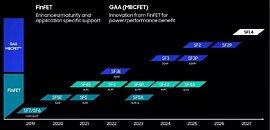- Joined
- Oct 9, 2007
- Messages
- 47,857 (7.38/day)
- Location
- Dublin, Ireland
| System Name | RBMK-1000 |
|---|---|
| Processor | AMD Ryzen 7 5700G |
| Motherboard | Gigabyte B550 AORUS Elite V2 |
| Cooling | DeepCool Gammax L240 V2 |
| Memory | 2x 16GB DDR4-3200 |
| Video Card(s) | Galax RTX 4070 Ti EX |
| Storage | Samsung 990 1TB |
| Display(s) | BenQ 1440p 60 Hz 27-inch |
| Case | Corsair Carbide 100R |
| Audio Device(s) | ASUS SupremeFX S1220A |
| Power Supply | Cooler Master MWE Gold 650W |
| Mouse | ASUS ROG Strix Impact |
| Keyboard | Gamdias Hermes E2 |
| Software | Windows 11 Pro |
Samsung Electronics is engaged in stiff competition with TSMC for chip manufacturing orders for 3 nm, its first semiconductor foundry node to implement GAA-FET technology, after nearly a decade of FinFET-based nodes. SF3, a 3 nm GAA-FET node, enters mass-production later this year. Samsung is claiming wafer yields in the range of 60-70% in the development phases of the node. This number is crucial to attract customers as they base their wafer orders squarely on yields first, and cost-per-wafer next.
Samsung is trying to rebuild confidence among chip designers after the 2022 controversy over its engineering "fabricating" yield numbers to customers to win their business. Samsung also stated that with 2023-2024 being dominated by 3 nm-class nodes, namely SF3 (3GAP), and its refinement the SF3P (3GAP+), the company will begin introducing its 2 nm class nodes in 2025-2026. Samsung's current customers for its 3 nm node include unnamed HPC processor designer, and a mobile AP (application processor) designer.

View at TechPowerUp Main Site | Source
Samsung is trying to rebuild confidence among chip designers after the 2022 controversy over its engineering "fabricating" yield numbers to customers to win their business. Samsung also stated that with 2023-2024 being dominated by 3 nm-class nodes, namely SF3 (3GAP), and its refinement the SF3P (3GAP+), the company will begin introducing its 2 nm class nodes in 2025-2026. Samsung's current customers for its 3 nm node include unnamed HPC processor designer, and a mobile AP (application processor) designer.

View at TechPowerUp Main Site | Source

